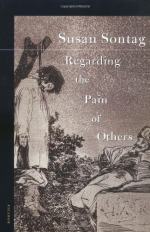
|
| Name: _________________________ | Period: ___________________ |
This test consists of 15 multiple choice questions and 5 short answer questions.
Multiple Choice Questions
1. Sontag discusses reactions to the attacks on the World Trade Center on September 11, 2001. Which of the following is NOT a reaction Sontag recalls hearing?
(a) "It felt unreal."
(b) "It felt surreal."
(c) "It felt like a dream."
(d) "It felt like a movie."
2. Sontag observes that "Here Is New York" had no need for captions, but suggests that:
(a) The photographers complained that their work did not receive proper explanation.
(b) Many people misunderstood the images.
(c) Many visitors were offended by the images they saw because they did not have a caption to explain them.
(d) One day, they will be necessary for those who did not experience the tragedy.
3. Krieg dem Kriege contains images captioned in which four languages?
(a) German, French, Dutch and English.
(b) German, French, English and Spanish.
(c) German, French, English and Russian.
(d) German, French, English and Japanese.
4. Sontag discusses the subtitle of "Here is New York" in some detail. What was this subtitle?
(a) "A Democracy of Images."
(b) "A City Mourns."
(c) "A Nation in Shock."
(d) "September 11th, 2001."
5. Images of the Gulf War were filtered to portray the "techno war." The public was exposed to only those images that portrayed which of the following sentiments?
(a) American military superiority over the enemy.
(b) Wondrous technological advancements.
(c) American military mercy.
(d) Savagery of conventional warfare, compared to American techno war.
6. Sontag argues that the most extensive kind of censorship is which of the following?
(a) Military censorship.
(b) The self-censorship of broadcast companies.
(c) Government censorship.
(d) The censorship implied by public sensibility.
7. Which of the following magazines was NOT devoted entirely to photography?
(a) Life.
(b) National Geographic.
(c) Vu.
(d) Picture Post.
8. Which of the following was NOT true of the "Here Is New York" exhibit?
(a) The images were displayed uncaptioned.
(b) Images were selected on a first-come, first-serve basis.
(c) One image from each contributer was selected.
(d) The identity of the photographer was kept secret until after the image was purchased.
9. The first war photographer, whose work garnered him the position as "official photographer" of the Crimean War, was which of the following?
(a) Edmund Gosse.
(b) Roger Fenton.
(c) Ernst Friedrich.
(d) Robert Capa.
10. Sontag argues that we are most disappointed to discover that which type of photographs have been staged?
(a) Images depicting intimate climaxes.
(b) Images depicting everyday life.
(c) Images depicting spontaneous events.
(d) Images depicting gory battle scenes.
11. Sontag argues that Woolf's view, like many other "antiwar polemicists" is:
(a) Out-dated.
(b) Generic.
(c) Narrow-minded.
(d) Idealistic.
12. Which was the first war to be covered by television cameras?
(a) The Korean War.
(b) The War on Terror.
(c) Desert Storm.
(d) The Vietnam War.
13. In its early days, photography was thought to:
(a) Depict a single, biased point of view.
(b) Glorify scenes of suffering.
(c) Diminish the emotional impact of an event.
(d) Represent objective truth.
14. Sontag argues that technological advances changed the way the public understands war by:
(a) Producing mass casualties and horrific destruction.
(b) Improving the power and accuracy of weapons.
(c) Shielding the public from scenes of the wounded and dying.
(d) Allowing journalists to represent the war in detail as it happens.
15. Which of the following is true about representations of the dead or dying in American media?
(a) American journalism favors American subjects, often overlooking people in "remote" places.
(b) American news media applies the same standards of decency to all victims, regardless of country of origin.
(c) The faces of the dead and dying from "exotic" places are more likely to be shown.
(d) FCC laws prohibit the printing of images including the faces of war victims.
Short Answer Questions
1. Sontag argues that witnessing war atrocities from afar is a unique experience characteristic of:
2. Sontag argues that a photograph by which of these photographers triggered mass outcry against the Vietnam War?
3. Sontag suggests that the camera always "kept company with _________".
4. Noting the long history of the "iconography of suffering," Sontag lists three types of art which depict incredible agony. Which of the following is NOT one of them?
5. The mass media bombarded viewers with shocking images because:
|
This section contains 719 words (approx. 3 pages at 300 words per page) |

|




